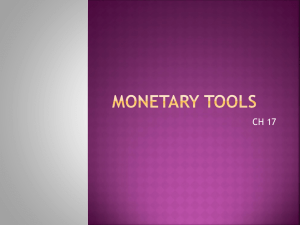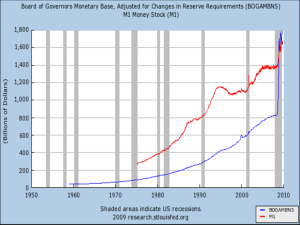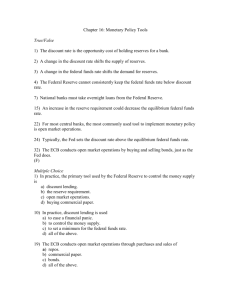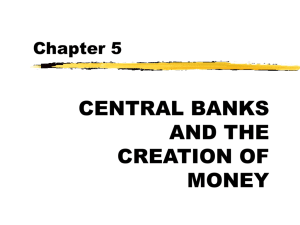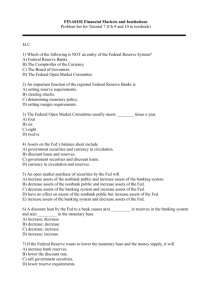The advantages of open market operations
advertisement
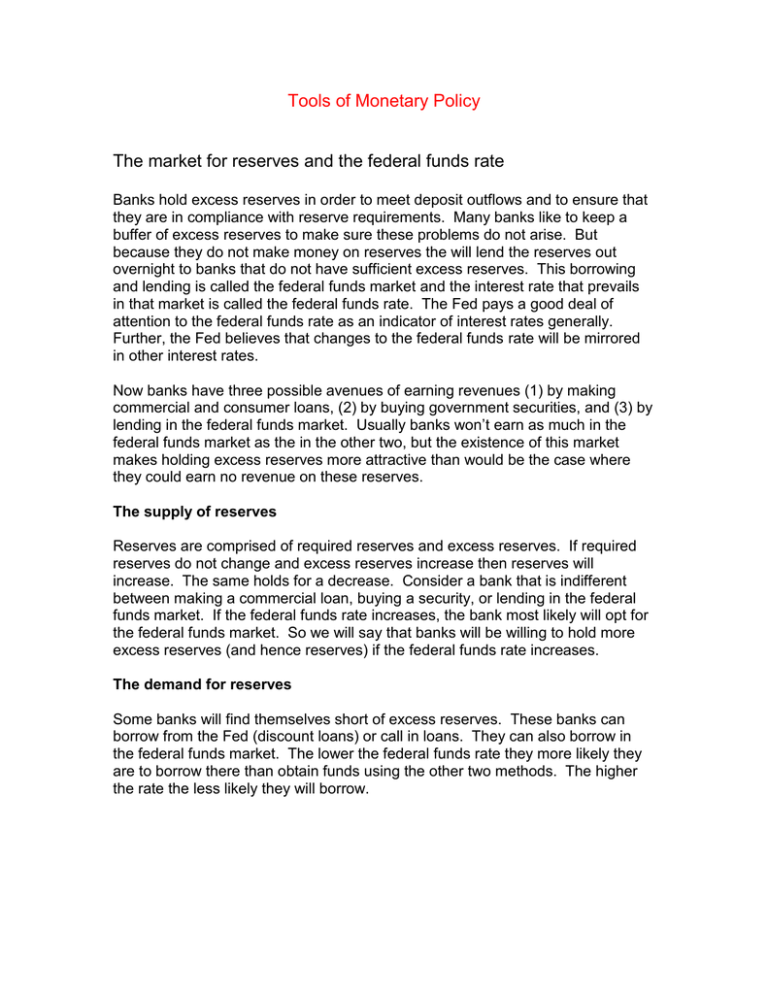
Tools of Monetary Policy The market for reserves and the federal funds rate Banks hold excess reserves in order to meet deposit outflows and to ensure that they are in compliance with reserve requirements. Many banks like to keep a buffer of excess reserves to make sure these problems do not arise. But because they do not make money on reserves the will lend the reserves out overnight to banks that do not have sufficient excess reserves. This borrowing and lending is called the federal funds market and the interest rate that prevails in that market is called the federal funds rate. The Fed pays a good deal of attention to the federal funds rate as an indicator of interest rates generally. Further, the Fed believes that changes to the federal funds rate will be mirrored in other interest rates. Now banks have three possible avenues of earning revenues (1) by making commercial and consumer loans, (2) by buying government securities, and (3) by lending in the federal funds market. Usually banks won’t earn as much in the federal funds market as the in the other two, but the existence of this market makes holding excess reserves more attractive than would be the case where they could earn no revenue on these reserves. The supply of reserves Reserves are comprised of required reserves and excess reserves. If required reserves do not change and excess reserves increase then reserves will increase. The same holds for a decrease. Consider a bank that is indifferent between making a commercial loan, buying a security, or lending in the federal funds market. If the federal funds rate increases, the bank most likely will opt for the federal funds market. So we will say that banks will be willing to hold more excess reserves (and hence reserves) if the federal funds rate increases. The demand for reserves Some banks will find themselves short of excess reserves. These banks can borrow from the Fed (discount loans) or call in loans. They can also borrow in the federal funds market. The lower the federal funds rate they more likely they are to borrow there than obtain funds using the other two methods. The higher the rate the less likely they will borrow. Figure 17__1. The federal funds market How monetary policy tools affect the federal funds rate Open market operations If the Fed buys securities it will increase reserves in the banking system. This shifts the supply curve for federal funds to the right and lowers the federal funds rate. An open market sale will reduce the level of reserves, shift the curve to the left and raise the federal funds rate. Discount loans When the Fed makes discount loans, reserves in the banking system increase. If the discount rate is lowered banks will tend to borrow more from the Fed and this will increase the supply of reserves. In that case the supply curve shifts right and the federal funds rate falls. If the Fed raises the discount rate banks will borrow less and reserves will fall. In this case the federal funds rate rises. Reserve requirements If the Fed raises the reserve ratio banks will convert excess reserve into required reserves. But now they will be holding less excess reserves than they would like. If they don’t call in loans or sell securities, they must borrow in the federal funds market. So an increase in the reserve atio will increase the demand for reserves (shift demand curve right), raising the federal funds rate. A decrease in the reserve ratio will shift the demand curve to the left lowering the federal funds rate. How the tools are used in practice Open market operations. There are two types of open market operations. Dynamic open market operations are used to change the monetary base to increase or decrease the money supply. Defensive open market operations are used to offset other things that might change the monetary base against the desire of the Fed (say changes in float). The Fed continuously monitors such things a float and Treasury deposits with the Fed that can change the monetary base. The Fed will then take action (usually open market operations) to offset an increase or decrease in reserves caused by the undesired changes in reserves. The advantages of open market operations 1. The Fed controls open market operations. It only has partial control of discount loans (the Fed can refuse to make loans but it can’t compel banks to borrow). 2. Open market operations are flexible. They can be made larger or smaller as needed. 3. Open market operations are easily reversed if a mistake has been made. 4. Open market operations can be implemented quickly. Discount Loans The Fed can affect the amount of discount borrowing in two ways 1. By changing the discount rate. It the Fed raises the discount rate banks will borrow less from the Fed. The supply of reserves will decrease and the federal funds rate will increase. If the Fed lowers the discount rate banks will borrow more, the supply of reserves will increase and the federal funds rate will decrease. 2. Administrative control of loans. The Fed makes three kinds of loans a) Adjustment credit loans. These are loans used by banks with short term liquidity problems caused by inadequate excess reserves. These loans can be approved very quickly and are expected to be paid back quickly. b) c) Seasonal credit. These are loans made to banks which need to make loans on a seasonal basis. Banks in agricultural areas and banks that service tourism and vacation industries are typical. Extended credit. These are loans make to banks with a severe liquidity problem due to large deposit outflow. The loan is not expected to be paid back quickly. The bank must justify the need for the extended credit and present a plan for restoring liquidity. While the Fed is willing to help banks out with occasional liquidity problems it does not want banks to make a habit of borrowing. In particular it does not want banks to view discount borrowing as a profit making activity. If the bank makes a habit of visiting the discount window the Fed will deny it loans in the future. Lender of last resort One of the functions of the Fed is to act as the lender of last resort to prevent bank panics. The very knowledge that the Fed is willing to act in such a fashion is often all that is needed to prevent such a panic. The Fed can always pump enough reserves into the economy by making discount loans as to meet deposit outflow problems. These loans can be made very quickly. The Fed did not act as the lender of last resort during the Great Depression. It let banks fail making the panic worse. Because the Fed did not act as the lender of last resort, banks had to protect themselves from deposit outflows by building up excess reserves. So banks refused to lend just when the economy needed lending the most. Why should the Fed need to be the lender of last resort if the FDIC exist? The FDIC is really rather small. It can be used to protect customers if a single bank fails, but really would be inadequate for a large scale banking panic. The Fed can also act as lender of last resort in financial crises that occur outside the commercial banking industry. During the Black Monday stock market crash of 1987, the Fed promised discount loans to banks that would, in turn, make loans to financially strapped securities firms. This seemed to have stopped the stock market panic and earned Greenspan much of his reputation. The lender of last resort policy has its own drawbacks. If banks believe that the Fed will always bail them out, they will be encouraged to engage in riskier behavior. This may be particularly true of large banks feeling that they are “too big to fail”. Announcement effect The Fed can use discount loan policy as a means of signaling to the financial community its plans regarding interest rates. If the Fed wishes to halt an inflationary expansion, it may decrease reserves thus raising the federal funds rate and follow this with an increase in the discount rate. It may be able to stop an expansion by raising the discount rate sending a signal that it will raise market interest rates if financial institutions don’t. That may be sufficient to halt the expansion. The problem is that the announcement may be misinterpreted. The Fed may raise the discount rate to discourage banks from applying for discount loans rather than as a signal that the Fed wants market rates to increase. Advantages and disadvantages of discount policy 1. When the Fed changes the discount rate this may be mistaken as a signal of future Fed interest rate policy. 2. Suppose that the Fed fixes the discount rate and then market interest rates rise. Banks will be encouraged to take out discount loans that will increase reserves. This may not be what the Fed wants to have happen. So this may make the Feds job more difficult. 3. Open market operations generally are more reliable and faster. Open market operations are easier to reverse if necessary. Changing reserve requirements The final monetary policy tool the Fed can use to affect the federal funds rate is by changing the reserve requirements. Increasing the reserve ratio will cause a shift from excess reserves to required reserves. Some banks that used to have excess reserves will now find that they do not have adequate reserves. They will borrow in the federal funds market. This will raise the federal funds rate. Lowering the reserve ratio will reduce the demand for excess reserves and will cause a fall in the federal funds rate. The Fed has had authority over the reserve requirement for commercial banks since the 1930s. Now it controls the reserve requirement for all depository institutions including commercial banks, S&Ls, mutual savings banks and credit unions. Advantages and disadvantages of reserve requirement changes The chief advantage of changing reserve requirements is that it affects all banks equally and is a very powerful tool. The chief disadvantage of changing reserve requirements is that it affects all banks equally and is a very powerful tool. Banks can choose to apply for discount loans. Banks can choose to buy or sell securities. Bank must comply with Fed decisions regarding reserve requirements. So banks lose a good deal of freedom when the Fed changes the reserve ratio. This will cause immediate liquidity problems for some banks due to no fault of their own. The tool is very powerful and hence should only be used with great care. Small changes in the reserve ration can cause very large changes in the money supply and the changes are not easy to predict. Should reserve requirements be 100% Milton Friedman has suggested that the reserve requirement be set at 100%. In this case there would be no excess reserves and the money multiplier would be m and 1 C D rD ER D C D 1 C D 1 0 D C D M m MB MB 1 C D 1 C D 1 so that the money supply would equal the monetary base. Friedman believes that this would give the Fed better control of the money supply (assuming they follow a constant growth rule for increasing the money supply). Of course banks could no longer make loans. These would have to be made by other financial institutions. Quite likely these institutions would develop instruments that looked like checkable deposits. Questions 1) In the market for reserves, an open market purchase shifts the supply curve to the A) left, lowering the federal funds interest rate. B) right, lowering the federal funds interest rate. C) right, raising the federal funds interest rate. D) left, raising the federal funds interest rate. 2) In the market for reserves, an open market _____ shifts the supply curve to the _____, lowering the federal funds interest rate. A) sale; left B) sale; right C) purchase; right D) purchase; left 3 In the market for reserves, a lower discount rate shifts the supply curve to the A) left, lowering the federal funds interest rate. B) right, lowering the federal funds interest rate. C) right, raising the federal funds interest rate. D) left, raising the federal funds interest rate. 4 In the market for reserves, a _____ discount rate shifts shifts the supply curve to the _____, lowering the federal funds interest rate. A) lower; left B) lower; right C) higher; right D) higher; left 5 In the market for reserves, a _____ discount rate shifts the supply curve to the _____, raising the federal funds interest rate. A) lower; left B) lower; right C) higher; right D) higher; left 6 In the market for reserves, an increase in the reserve requirement shifts the demand curve to the A) left, lowering the federal funds interest rate. B) right, lowering the federal funds interest rate. C) right, raising the federal funds interest rate. D) left, raising the federal funds interest rate. 7) the market for reserves, a _____ in the reserve requirement shifts the demand curve to the left, _____ the federal funds interest rate. A) rise; lowering B) decline; raising C) decline; lowering D) rise; raising 8) Open market operations intended to offset movements in noncontrollable factors (such as float) that affect reserves and the monetary base are called A) defensive open market operations. B) dynamic open market operations. C) offensive open market operations. D) reactionary open market operations. 9 The Fed's most commonly used means of changing the money supply is A) changing reserve requirements. B) changing the discount rate. C) open market operations. D) changes in the Regulation Q ceiling rate. 10) Fed's least commonly used means of changing the money supply is A) changing reserve requirements. B) changing the discount rate. C) open market sales. D) open market purchases. 11) The discount rate is A) the interest rate the Fed charges on loans to banks. B) the price the Fed pays for government securities. C) the interest rate that banks charge their most preferred customers. D) the price banks pay the Fed for government securities. 12) A) B) C) D) The major loan extended to Continental Illinois in 1984 is an example of which type of discount loan? Seasonal credit Extended credit Adjustment credit Installment credit 13) The most common type of discount loan, _____ credit loans, are intended to help banks with short-term liquidity problems that often result from temporary deposit outflows. A) extended B) adjustment C) temporary D) seasonal 14) The most common type of discount loan, _____ credit loans, are intended to help banks with _____-term liquidity problems that often result from _____ deposit outflows. A) extended; short; temporary B) adjustment; short; temporary C) extended; long; permanent D) seasonal; long; permanent 15) The Fed's ability to discourage banks from making too many trips to the discount window is frequently referred to as A) "arm twisting." B) the "red dog" rule. C) "discount blitzing!" D) "moral suasion." 16) When the Federal Reserve was created, its most important role was intended to be as A) a storage facility for the nation's gold. B) a lender-of-last-resort. C) a regulator of bank holding companies. D) none of the above. 17) Of the three policy tools that the Fed can use to change the money supply, the one that does not affect the monetary base is A) open market operations. B) changes in the discount rate. C) changes in the federal funds rate. D) reserve requirements. 18) If the banking system has a large amount of reserves, many banks will have excess reserves to lend and the federal funds rate will probably _____; if the level of reserves is low, few banks will have excess reserves to lend and the federal funds rate will probably _____. A) fall; fall B) fall; rise C) rise; fall D) rise; rise 19) Open market operations as a monetary policy tool have the advantages that A) they occur at the initiative of the Fed. B) they are flexible and precise. C) they are easily reversed if mistakes are made. D) all of the above. 20) Adjustment credit A) can be obtained with a telephone call. B) is expected to be repaid fairly quickly. C) is the least common type of discount loan. D) is all of the above. E) is only (a) and (b) of the above. 21) Adjustment credit A) can be obtained with a telephone call. B) is expected to be repaid fairly quickly. C) is the least common type of discount loan. D) is all of the above. E) is only (a) and (b) of the above. 22) Discount policy A) can be used to signal the Fed's intentions about future monetary policy. B) can be important in preventing financial panics. C) is the Fed's preferred method for changing the level of reserves in the banking system. D) all of the above. E) only (a) and (b) of the above. 23) A financial panic was averted in October 1987 following "Black Monday" when the Fed announced that A) it was lowering the discount rate on extended credit. B) it would provide discount loans to any bank that would make loans to the security industry. C) it stood ready to purchase common stocks to prevent a further slide in stock prices. D) all of the above. 24) The Fed is reluctant to use reserve requirements to control the money supply and interest rates because A) of their overly-powerful impact on the money supply. B) they have the potential to create liquidity problems for banks with low excess reserves. C) frequent changes in reserve requirements complicate liquidity management for banks. D) of all of the above. E) of only (a) and (b) of the above. 25) The most important advantage of discount policy is that the Fed can use it to A) signal its intentions about future monetary policy. B) perform its role as lender of last resort. C) control the money supply. D) punish banks that have deficient reserves.


